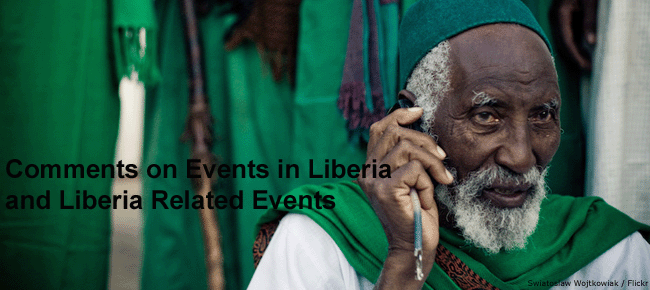Monday, October 20
Nine Blogs and Three Books - The True Liberian Spirit
The civil war left more than 200,000 peope dead and made many more victims: wounded or disabled people, child-soldiers, orphans, who had to restart their lives, often struggling with a trauma caused by unforgettable cruelties. When President Ellen Johnson Sirleaf took office, in January 2006, Liberia's infrastructure was in shambles, the economy ruined, most (foreign) investors gone. Yet, despite all difficulties and impossibilities, the Liberian spirit is alive. Isn't there a saying 'Tough times don't last, but tough people do!' ?
Recently, three Liberian authors drew national and international attention with their books related to the Liberian crisis. Is it a coincidence that all three were women? They follow the footsteps of other Iron Ladies of Liberia, headed by President Ellen Johnson Sirleaf. First there is Elma Shaw with her novel 'Redemption Road - The Quest for Peace and Justice in Liberia'. A very interesting book review and interview can be found here. Then there is Helene Cooper who wrote 'The House at Sugar Beach - In Search of a Lost African Childhood'. Read the very informative September 10 book reviews on Shellby Grossman's blog and Emmanuel's blog if you want to know more about the book and Helene Cooper.
The third book will be published early 2009. It is Diana Taylor's 'Black Diamond'. It absolutely is an extraordinary book with a fascinating theme. The book announcement reads as follows:
"At sixteen, Ellen was a normal young Liberian girl. Her father called her 'Black Diamond', because she was so precious to him. But Liberia was being torn apart by civil war, a war that would destroy almost everything she loved. Government soldiers murdered Diamond's parents in front of her. Diamond herself was then brutally raped, stabbed, and left for dead. Miraculously she survived. When she was strong enough she made an astonishing decision - to return to Liberia and fight on the side of the rebel forces. Rising quickly through the ranks Diamond became a leader of her own battalion of women. Many believed 'Black Diamond' must be a myth or a supernatural being - but in fact she was just a young girl, fearful but determined to create a better future for her country. This is her dramatic and heartbreaking true story of survival and courage - and of her struggles to create a new life both for herself and the women who fought with her. "
Now, after the war, Ellen tries to rebuild her life. She is tired of fighing, the war, and reflects on the future: 'We realized our goal. Charles Taylor is gone. I want to go back to school.'
The latest proof of the strong Liberian spirit - a survivor's spirit - I found while reading David Sasaki's blog. David writes about the free press in Liberia and how Liberian journalists become bloggers. His blog is part of an interesting site, Rising voices - Helping the global population join the global conversation. David describes how Liberians take advantage of modern media tools like blogs and photo-sharing sites. After a morning workshop at the US embassy in Monrovia, nine Liberian journalists have begun sharing their lives and stories with us on their newly created blogs. Here follows a list of their blogs:
http://firstnewsliberia.wordpress.com/
http://moussomag.wordpress.com/
http://bensliberia.wordpress.com/
http://jskpenneh.wordpress.com/
http://sengbeh.wordpress.com/
http://judicialreporternetwork.wordpress.com/
http://wwwtheforumnews.wordpress.com/
http://azangoliberia.wordpress.com/
http://gusdjaeploe.wordpress.com/
They cover different topics: sports, politics, diplomacy, the press, grassroots organizations, and - of course - the persistent scars of the civil war.
Does anybody know how long it takes for memories to become history?
We don't know the answer to this question, but I want to thank and congratulate the three authors and the nine bloggers with their contribution to history and the rebuilding of the Liberian society!
2008/10/20
2008/10/05
Sunday, October 5
Rape of a Nation
Today, by accident, I stumbled upon the magnificent website of Marcus Bleasdale, a former trader of interest-rate derivatives for the Bank of America, turned photojournalist. In 1998, after having won an award for being a rising young photojournalist, he worked in Sierra Leone and later in Central Africa. Reading Joseph Conrad's Heart of Darkness he became intrigued with the Democratic Republic of Congo (DRC).
Conflicts among warlords, rebel groups and government forces over control of the country's mineral wealth have left more than 5 million people dead since 1998 and created a humanitarian crisis in the country. Bleasdale made an impressive video called 'Rape of a Nation'. I think you shouldn't miss this movie because of the similarities with the Liberian civil war, except for the numbers.

Unlike the DRC, the Liberian war has ended. Both countries face the same problem: how to overcome the scars of the war.
Rape of a Nation
Today, by accident, I stumbled upon the magnificent website of Marcus Bleasdale, a former trader of interest-rate derivatives for the Bank of America, turned photojournalist. In 1998, after having won an award for being a rising young photojournalist, he worked in Sierra Leone and later in Central Africa. Reading Joseph Conrad's Heart of Darkness he became intrigued with the Democratic Republic of Congo (DRC).
Conflicts among warlords, rebel groups and government forces over control of the country's mineral wealth have left more than 5 million people dead since 1998 and created a humanitarian crisis in the country. Bleasdale made an impressive video called 'Rape of a Nation'. I think you shouldn't miss this movie because of the similarities with the Liberian civil war, except for the numbers.

Unlike the DRC, the Liberian war has ended. Both countries face the same problem: how to overcome the scars of the war.
Subscribe to:
Comments (Atom)

